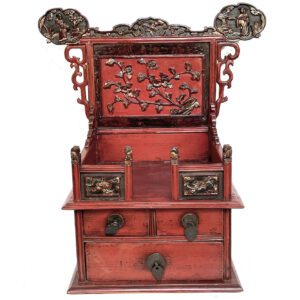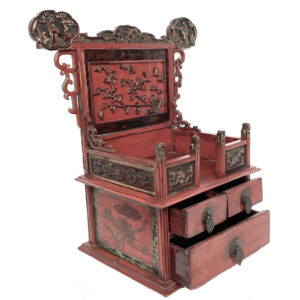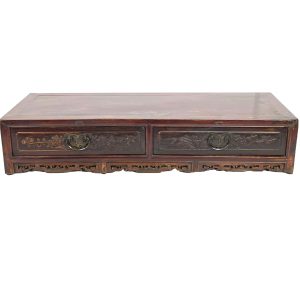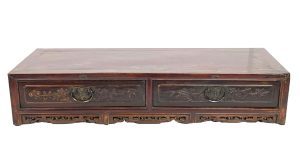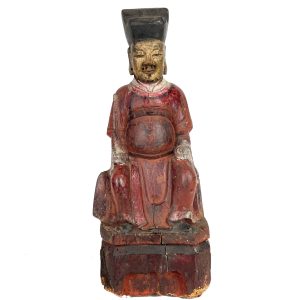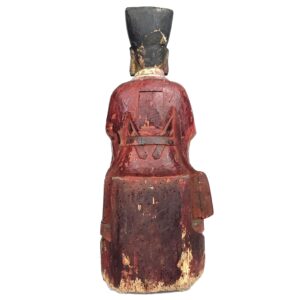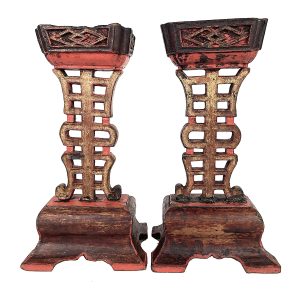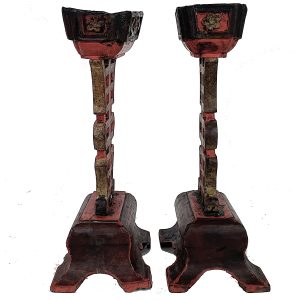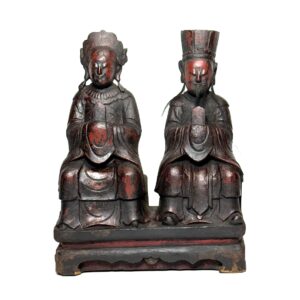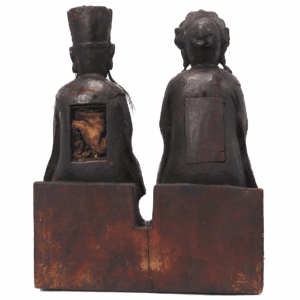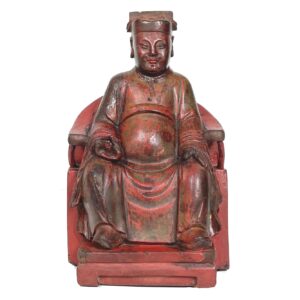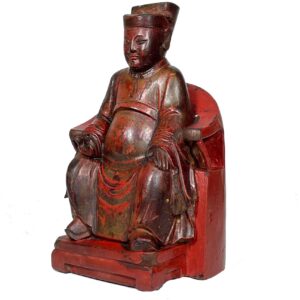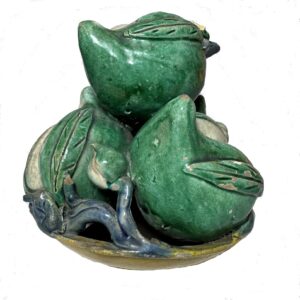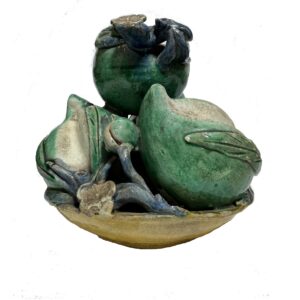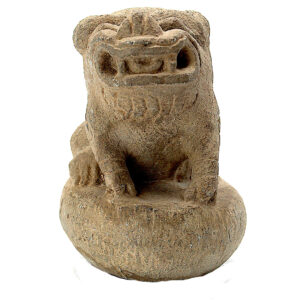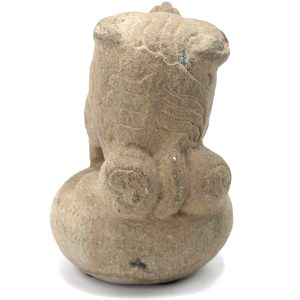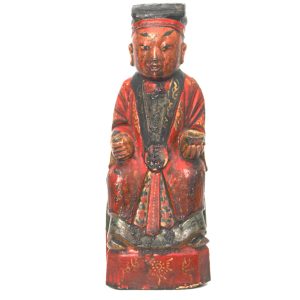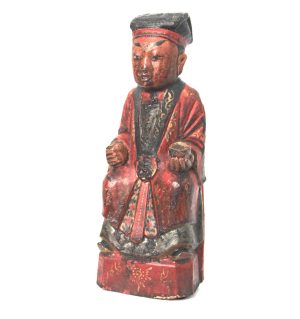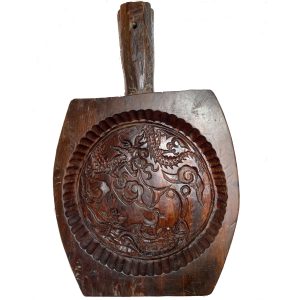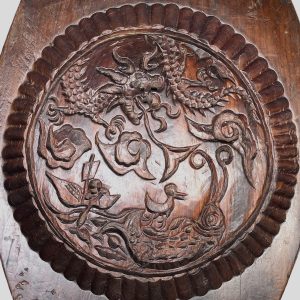Showing 13–24 of 29 results
-
Sale!


$695.00 Original price was: $695.00.$495.00Current price is: $495.00.
Ht: 20.75” W: 19.125” D: 11” |CALL 213-568-3030 OR EMAIL [email protected] FOR SHIPPING COST
Fine ladies vanity cabinet covered with red lacquer and gold highlights. Parents’ gift to newlyweds with auspicious symbols for happiness, long life and having sons reflecting Confucian belief that producing sons to carry on the family name is essential to happiness.
-
Sale!


$595.00 Original price was: $595.00.$375.00Current price is: $375.00.
H: 5.625″ W: 27.875″ D: 9.75″ | CALL 213-568-3030 OR EMAIL [email protected] FOR SHIPPING
Charming antique low profile lacquered finished chest adds warmth to any setting. Drawers with carved auspicious symbols for the Five Happinesses include peonies, vines, butterflies, plum blossom and a Japanese lily. Inset panel with florals and decorative apron and brass butterfly handles.
-
Sale!


$875.00 Original price was: $875.00.$495.00Current price is: $495.00.
H: 15.5″ W: 6.125 ” 4.125 D: ” | FREE SHIPPING WITHIN CONTINENTAL U.S.
Carved ancestor figure as an official sits on a backless chair with a decorative pedestal in official’s attire holding a long slender curved hu-tablet, all signs of his office and status. He is vibrantly painted in red, the color of fu, as a wish for prosperity and status.
-
Sale!


$295.00 Original price was: $295.00.$165.00Current price is: $165.00.
H:9.25 ” W: 5.25 ” D: 3.5 ” | CALL 213-568-3030 OR EMAIL [email protected] FOR SHIPPING.
Pair of oil lamps for good fortune with diamond shaped double lozenge meaning many treasures, and plum blossoms, symboling the Five Happinesses – wealth, health, longevity, peaceful death and love of virtue.
-
Sale!


$995.00 Original price was: $995.00.$695.00Current price is: $695.00.
H: 10″ W: 7.75″ D: 8.25″ | FREE SHIPPING WITHIN CONTINENTAL U.S.
Rare single image of Kitchen God and wife, indicating their close/lasting relationship as family’s protectors. Detailed elaborate officials’ robes, headgear. Individually portrayed holding hu tablets like those held by high court officials or Taoist priests.
-
Sale!


$650.00 Original price was: $650.00.$385.00Current price is: $385.00.
H: 7.25” W: 4.625” D: 3.5” | FREE SHIPPING WITHIN CONTINENTAL U.S.
Finely carved ancestor displaying status symbols: official’s attire and hat, horseshoe chair with feet on pedestal. Painted and lacquered front and back in red, traces of gilt, colors of “fu” as a wish for wealth, health and long life, aged from years of use into a great patina.
-
Sale!


$450.00 Original price was: $450.00.$295.00Current price is: $295.00.
Ht: 5.5” Dia: 6” | FREE SHIPPING WITHIN CONTINENTAL U.S.
Shiwan stoneware peaches and lotuses on footed bowl auspicious symbols associated with springtime, fertility, long healthy life for many generations and therefore are propitious gifts for birthdays, especially for the elderly.
-
Sale!


$195.00 Original price was: $195.00.$155.00Current price is: $155.00.
H: 4.5″ Dia: 3.25″ | FREE SHIPPING WITHIN CONTINENTAL U.S.
This stone flu lion is not an elegant protective beast, it’s just a friendly pet hanging out. He probably lived in a garden and is looking for another one with people like old wonderful pieces to remind them not to take themselves too seriously.
-
Sale!


$295.00 Original price was: $295.00.$195.00Current price is: $195.00.
H: 7.25″ W: 2.75″ D :2″ | FREE SHIPPING WITHIN CONTINENTAL U.S.
Colorful Taoist priest carving holding a cup with the Elixir of Life granting eternal life. Red is the color of fu to bring into the home divine favors. Whimsically painted face and raised lacquer decorations, it was consecrated and originally placed on a home altar.
-
Sale!


$425.00 Original price was: $425.00.$310.00Current price is: $310.00.
Ht: 1.25″ W: 15″ D:14.87″ | CALL 213-568-3030 OR EMAIL [email protected] FOR SHIPPING COST
This intricately hand carved gold and silver platter with indentations on both sides was used to make confections called sweetmeats eaten at festivals, holidays, and other key celebrations. The round molds symbolize the moon and cohesion of the family. The 5-petal plum blossoms attached to vines symbolize purity and endurance, as well as the coming of spring, renewal, and longevity. The multiple seeds are a wish for fertility and sons, and thus this mold may have been a holiday and/or marriage gift to a young couple.
-
Sale!


$625.00 Original price was: $625.00.$425.00Current price is: $425.00.
H: 8.25″ W: 3.125″ D: 2.25″ | FREE SHIPPING!
This Kitchen God and his Wife is posed as streamlined virtual mirror-images and fashioned with a general quality relying on paint rather than deep carving for details. They sit on backless chairs on a plinth, with simplified gold officials’ robes with long color sashes, and well-carved black and gilt head gear. The wife’s face is smooth, generalized and the male face has a more deeply carved surface and painted highlights.
-
Sale!


$425.00 Original price was: $425.00.$215.00Current price is: $215.00.
H: 16.5″ W: 10.5″ D: 2.25″ CALL 213-568-3030 OR EMAIL [email protected] FOR SHIPPING QUOTE
This finely detailed hardwood mold was used to make sweetmeats confections, perhaps mooncakes for the Chinese Autumn Moon Festival. It is covered with deeply carved propitious symbols for marital harmony, sons and successful endeavors: a four clawed dragon for fertility, two ducks symbolizing marital bliss and harmony, one atop a carp for conjugal bliss and achieving noble rank and a boat with a sail for making all this easy sailing. This would be a great accessory or gift (especially for weddings) to spice up any kitchen.
End of content
End of content

